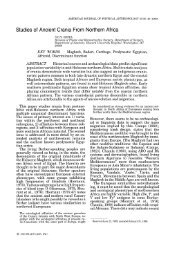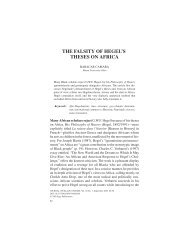Dutch Slavery and Slave Trade in the Indian Ocean
Dutch Slavery and Slave Trade in the Indian Ocean
Dutch Slavery and Slave Trade in the Indian Ocean
Create successful ePaper yourself
Turn your PDF publications into a flip-book with our unique Google optimized e-Paper software.
154 journal of world history, june 2003<br />
In addition, “rebellious” peoples, once subdued, were often forced at<br />
gunpo<strong>in</strong>t to sign treaties with slave clauses, promis<strong>in</strong>g <strong>the</strong> delivery of a<br />
fixed number of slaves <strong>and</strong> o<strong>the</strong>r commodities as f<strong>in</strong>e or tribute (boete<br />
ofte amende). The symbolic exchange of gifts reestablished relationships<br />
<strong>and</strong> reordered <strong>the</strong> proper hierarchy between <strong>in</strong>dividuals, groups,<br />
<strong>and</strong> <strong>the</strong> “honorable” company. Between 1650 <strong>and</strong> 1675 alone, <strong>the</strong><br />
<strong>Dutch</strong> concluded numerous slave-clause agreements with <strong>in</strong>digenous<br />
chiefs <strong>and</strong> headmen (orangkayas, penghulus, sangajis, <strong>and</strong> so forth) on<br />
<strong>and</strong> near <strong>the</strong> isl<strong>and</strong>s of Sumatra, Timor, New Gu<strong>in</strong>ea, <strong>and</strong> Sulawesi. 55<br />
Accord<strong>in</strong>g to <strong>Dutch</strong> Roman law, slavery was hereditary through <strong>the</strong><br />
female “on <strong>the</strong> pr<strong>in</strong>ciple that <strong>the</strong> fruit follows after <strong>the</strong> womb.” Offspr<strong>in</strong>g<br />
from female slaves, however, was a relatively <strong>in</strong>significant source<br />
of captive labor due to low levels of reproduction among slave populations.<br />
Despite several “moments of creolization” (when <strong>the</strong> slave population<br />
was more than 50% locally born), <strong>the</strong> gender imbalance among<br />
slaves (i.e., an overwhelm<strong>in</strong>g preponderance of male slaves especially<br />
among non-company slaves), high mortality rates, <strong>and</strong> poor liv<strong>in</strong>g <strong>and</strong><br />
work<strong>in</strong>g conditions limited female fertility <strong>and</strong> weighed heavily aga<strong>in</strong>st<br />
natural reproduction. 56<br />
In 1682, for <strong>in</strong>stance, <strong>the</strong> slave population of Malacca consisted of<br />
1,589 adults (880 men <strong>and</strong> 709 women) <strong>and</strong> 264 children, an adult-tochild<br />
ratio of 6.0:1 (see Table 3). In 1687, <strong>the</strong> Cape slave population<br />
consisted of 758 adults (503 men <strong>and</strong> 253 women) <strong>and</strong> 145 children<br />
(ratio 5.2:1), while <strong>the</strong> <strong>Dutch</strong> settlements along <strong>the</strong> Malabar coast<br />
(Coch<strong>in</strong>, Quilon, Cannanur, Cranganur, <strong>and</strong> Pallipuram) had 716<br />
adults (536 men <strong>and</strong> 180 women) <strong>and</strong> 137 children (ratio 5.2:1). In<br />
1688, <strong>the</strong> slave population of Ambon consisted of 8,335 adults (4,446<br />
men <strong>and</strong> 3,889 women) <strong>and</strong> 2,381 children (ratio 3.5:1), whereas<br />
B<strong>and</strong>a had 3,213 adults (1,631 men <strong>and</strong> 1,582 women) <strong>and</strong> 503 children<br />
(ratio 6.4:1). In 1689, <strong>the</strong> slave population of Batavia consisted<br />
of 22,570 adults (12,557 men <strong>and</strong> 10,013 women) <strong>and</strong> 3,501 children<br />
(ratio 6.4:1). 57<br />
Judicial punishment, <strong>in</strong> <strong>the</strong> form of political exiles <strong>and</strong> convicts<br />
55 Heeres, ed., Corpus Diplomaticum Neerl<strong>and</strong>o-Indicum II, pp. 500, 678–79, 749–50;<br />
III, pp. 320, 384, 490, 529, 602, 605, 620, 845–46, 850, 881.<br />
56 Shell, Children of Bondage, pp. 46–48; Hovy, Ceylonees Plakkaatboek I, pp. 309–10,<br />
395; De Haan, Oud Batavia I, p. 456.<br />
57 VOC 1434, OBP 1688, fls. 263v–265v, Samentrekk<strong>in</strong>g Huijsgez<strong>in</strong>nen Coch<strong>in</strong> . . .,<br />
17.12.1687; Generale Missiven IV, p. 554; idem V, pp. 202, 203–204; Shell, Children of<br />
Bondage, p. 445.




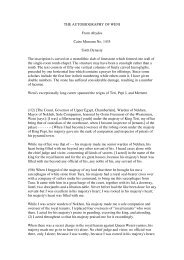
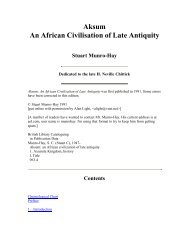
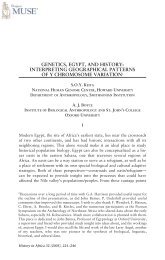

![The Negro trail blazers of California [microform] : a ... - Homestead](https://img.yumpu.com/32436613/1/174x260/the-negro-trail-blazers-of-california-microform-a-homestead.jpg?quality=85)

